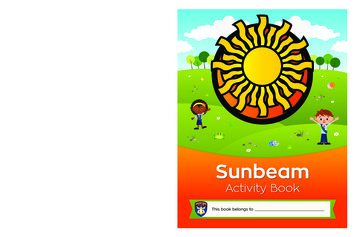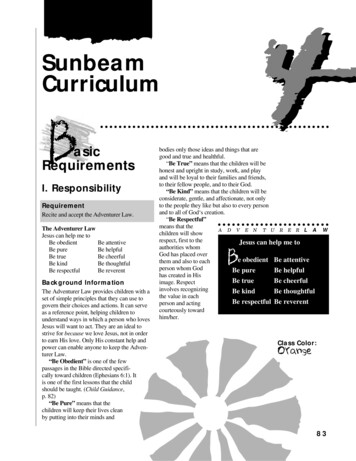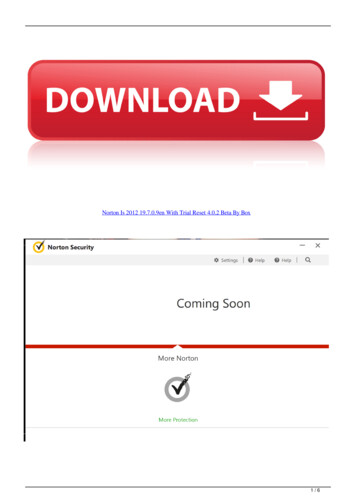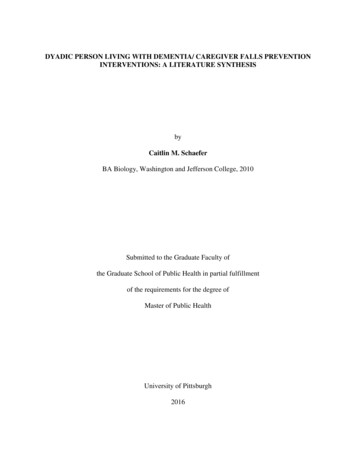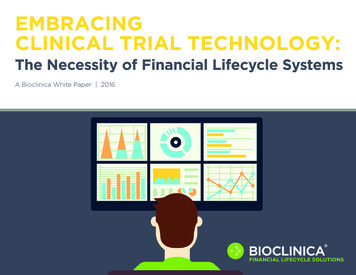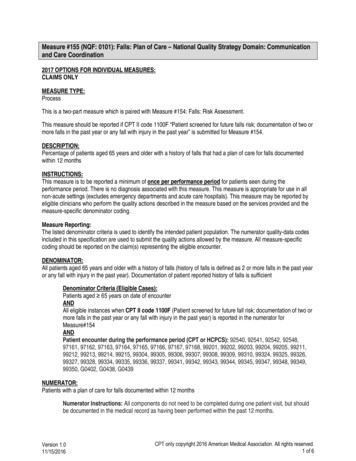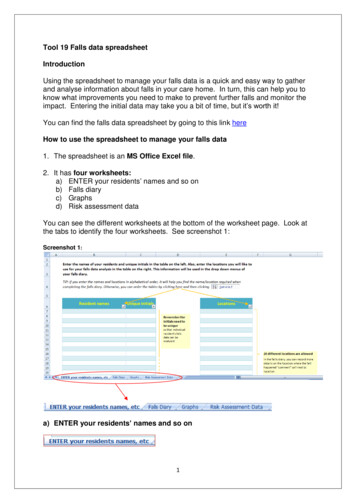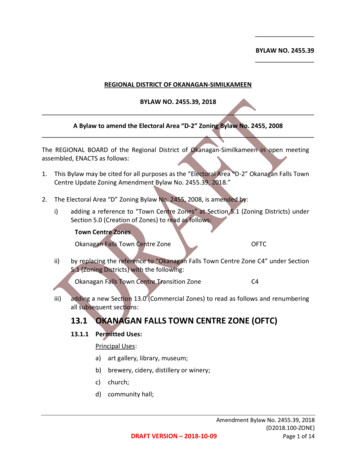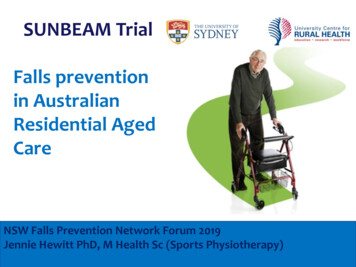
Transcription
SUNBEAM TrialFalls preventionin AustralianResidential AgedCareNSW Falls Prevention Network Forum 2019Jennie Hewitt PhD, M Health Sc (Sports Physiotherapy)
The impact of falls in residential aged care(RAC) 30-35% of community dwellers fall once per year(65 y ) (Sherrington 2019) 60-63% of residents of aged care fall each year2.51 falls per person year (Kennedy 2015) Falls in this population are often traumatic – theleading cause of preventable death in RAC(Ibrahim 2017)
The impact of falls on society Australia’s residential aged care (RAC)population is projected to more than treble by2050 (AIHW 2017) The number of people living in residential agedcare, fall related hospital admissions and costs offollow up care are rising (AIHW 2017) No other single injury, including road trauma,costs the health system more than injuriesresulting from falls (Bradley 2012)
Why do people fall?Falls not purely random events –can be predictedby assessing a number of risk itaminD
Falls prevention researchCOCHRANE REVIEWS“Interventions for preventing falls in elderlypeople” (Gillespie et al 2003)Interventions forpreventing falls in olderpeople living in thecommunityInterventions forpreventing falls in olderpeople living in nursingcare facilities and hospitals(Gillespie et al 2009,2012, 2019)(Cameron et al 2010, 2012, 2018)
Falls in the community (Gillespie et al 2009)Factors that reduce falls in community dwellers: Multi-component group exercise – balance, resistance eg. Stepping On (Clemson et al 2004)Tai ChiOtago Exercise Program (Robertson et al 2002) Multifactorial intervention customised to individual needs Withdrawal of psychotropic medsPacemakersCataract surgeryThere is clear evidence that exercise is beneficial for theprevention of falls in the community
Falls in residential aged care(Cameron et al 2012, and 2018)Factors that reduce falls in residents of aged care facilities: Vitamin D supplementationFactors that may reduce falls in residents of aged care facilities: Multifactorial interventions customised to individual needsResults relating to the effectiveness of exercise in reducingthe rate of falls and risk of falling are inconsistent (Cameron et al2012, 2018)There are currently no RCT to recommend for or against theuse of customised exercise programs to prevent falls in longterm aged care settings” (Clinical Practice Guidelines AGS/BGS 2011)
Cameron et al 2010
Components of effective exerciseprograms Total dose of exercise – 50 hours minimum High level balance work Strength work for those who are deconditioned All exercises individually upgraded – progressed Close supervision – to allow for safe inclusionof high level balance work Maintenance program continued after initial conditioning phase Walking program (while beneficial for other health conditions)should not be considered a falls prevention program(Sherrington et al 2011, Tiedeman et al 2011)
Studies showing reduction in fall ratesShimada et al 2004 (n 26, 6 months follow - up) Perturbed walking using a bilateral separated treadmill v usualcare 3 x weekly 6 months up to TOTAL 100 hoursSihvonen et al 2006 (n 27, 1 year follow up) Visual feedback based balance training (computer screen,balance plate causing perturbations) v usual care 30 mins 3 x per week 4 weeks TOTAL 6 hours
Studies showing no change in fall ratesChoi et al 2005 (n 68, 12 week follow up) Tai Chi v usual care 35 mins 3 x per week 12 weeks TOTAL 21 hoursSakamoto et al 2006 (n 527, 6 month follow up) Uni – pedal standing v usual care 6 mins per day 7 x per week26 weeks TOTAL 18.2 hours
Pooled data from these studies showedan increase in fall ratesFaber 2006 (n 278, 1 year follow up) “Functional walking” 1x weekly for 4 weeks then 3 x weekly for 16 weeks for 1 hour each TOTAL 52 hoursMulrow 1994 (n 194, 4 month follow up) ROM ex, leg weights until deemed able to walk well then progressed to walking 3 x weekly for 16 weeks – 30 mins each TOTAL 24 hoursSchoenfelder (2000) (n 16, 6 months follow up) Heel raises 5-10 reps as able, 10 mins walking 3 x weekly for 3 months x 20 mins each session (TOTAL 12 hours)Rosendahl 2008 (n 191, 6 month follow up) Balance, Squats, stepping up/down, walking program 45 mins 5 x every 2 weeks for 13 weeks – total 29 occasions (TOTAL 21.75 hours)
Exercise as medicine.TypeDosageFrequencyAll matter Would I prescribeparacetamol to correctBSL in Diabetes 1?
Components of effective exerciseprograms Total dose of exercise – 50 hours minimum High level balance work Strength work for those who are deconditioned All exercises individually upgraded – progressed Close supervision – to allow for safe inclusionof high level balance work Maintenance program continued after initial conditioning phase Walking program (while beneficial for other health conditions)should not be considered a falls prevention program(Sherrington et al 2011, Tiedeman et al 2011)
Objectives of theSUNBEAM trial.The key research questions were: Is a supervised progressive resistance training and balance groupbased exercise program more effective than usual care forprevention of falls among residents over a 12-month follow-upperiod? Does the program result in improvements to the secondaryoutcomes: quality of life, cognition, mobility and confidence? Is the program cost effective?
RESEARCH DESIGN – SUNBEAM TRIAL Multi-centre Cluster randomisedcontrolled trial Concealed allocation Assessor blinded 16 Clusters 221 Participants
Acknowledgements Professor Kathryn Refshauge Professor Stephen Goodall Professor Lindy Clemson Dr Tim HenwoodHUR Health and Fitness EquipmentFeros Care
Strength andBalance Exercisein Aged CareSUNBEAMPROGRAMNAME VOTED MOST POPULAR BYPARTICIPANTS
Participants at BaselineCharacteristicAgeFemaleMonths in RACFHigh Care ACFIFalls in prior 12 monthsFallersDiagnosed co-morbid conditions:Anxiety/ DepressionArthritisCardiac DiseaseCognitive ImpairmentDiagnosed Gait/balance DisorderHypertensionOsteoporosisMS PainVisual ImpairmentPrescribed Vitamin DIntervention Group(n 113)86.04 (SD 6.77)7122.88 (SD 27.57)Range 1-192611896986745463866940603830%Usual Care Group(n 108)61.0186.65 (SD 7.17)7326.07 (SD 24.6)Range 1
The Intervention
Falls outcomesHewitt et al JAMDA (19) 2018; 361-369
Primary outcome at 12 monthsFalls rate2.911.31Incidence rate ratio0.45 (95% CI 0.17-0.74)SunbeamUsual careHewitt J, Goodall S, Clemson L, Henwood T, Refshauge K. Progressive resistanceand balance training for falls prevention in long term residential aged care: Acluster randomised trial of the Sunbeam Program. JAMDA 2018; (19): 361-369.
Interviews
Trying to change a system Disillusionedwith currentservices inRACFSearch forevidenceCluster RCTLobby forchange
Costs of treating a fall
Calculating cost effectivenessIncremental cost effectiveness ratio (ICER)cost of intervention - cost of usual careeffect of intervention - effect of usual careICER 22 per fall avoided 18 per fall avoided (95% CI: 380.34 to 417.85).Hewitt J, Goodall S, Saing S, Clemson L, Henwood T, Refshauge K. Cost effectiveness of the
Scenario - All Australian RAC implemented theprogram172 000 residents x 0.25 43 000“Current care” 125 130 fallsAcute cost 400.09 per fall 50 M“Sunbeam program” 56 330 fallsAcute cost 400.09 per fall 23 MEstimated cost benefit 27 M
Scenario – Including all acute and long termcare costs:172 000 residents x 0.25 43 000 inclusions“Current care”Cost 1750 per fall 125 130 falls 219 M“Sunbeam program”Cost 1750 per fall 56 330 falls 99MEstimated cost benefit 120 M
Disseminating the results RCT Publication CE Publication Share findings with thoseresponsible for reform Lobby for change
TRANSLATION TO POLICYDr Richard Rosewarne, Janet Opie, Dr Richard Cumpston, Victoria Boyd and AkiraKikkawa.
TRANSLATION TO POLICY:Key Recommendation:
TRANSLATION TO PRACTICEComponents of effective exerciseprograms in residential aged care Total dose of exercise 1.2 hours/week (min) Progressive resistance training (2-3 sets, 10-15 reps) High level balance work All exercises individually upgraded and progressed Close supervision Maintenance program continued after initialconditioning phase
TRANSLATION TO PRACTICEProgressive resistance training (2-3 sets, 10-15 reps)Muscle groups included in Sunbeam Program: Knee flexors and extensors Hip extensors, abductors, adductors Elbow flexors and extensors Shoulder retractors Calves
No gym?
TRANSLATION TO PRACTICEHigh challenge balance exerciseExercises included in Sunbeam Program: Standing bicep curls and shoulder retraction Heel raises Dynamic balance - recovery steps, grapevine Static balance – feet SBS, stride, semi tandem, tandemEyes open, eyes closed ROBOS
Balance with flair
Thank you for egratedliving.org.au
Jennie Hewitt PhD, M Health Sc (Sports Physiotherapy) The impact of falls in residential aged care (RAC) 30-35% of community dwellers fall once per year (65 y ) . Scenario -Including all acute and long term care costs: 172 000 residents x 0.25 43 000 inclusions "Current care" 125 130 falls Cost 1750 per fall 219 M .

